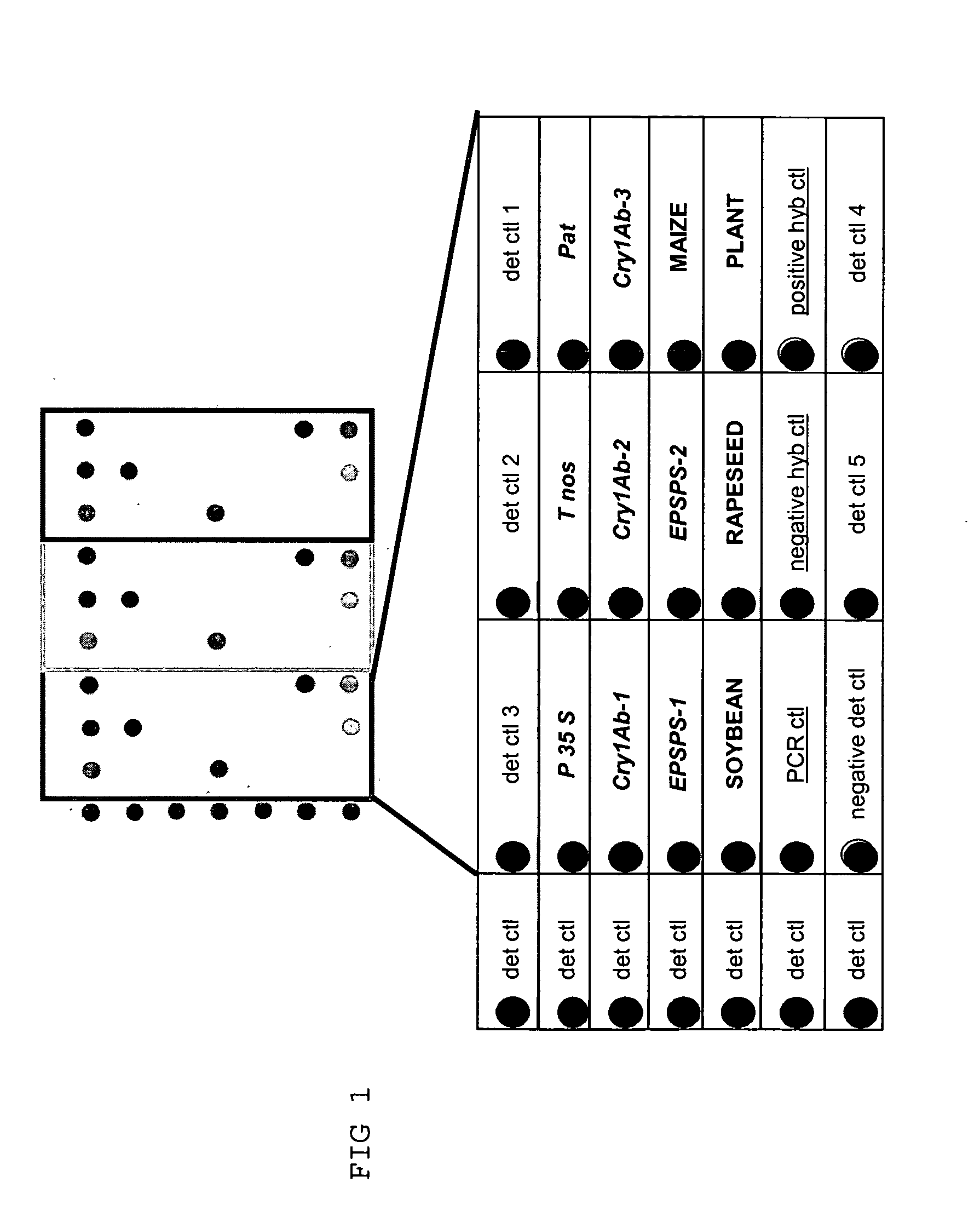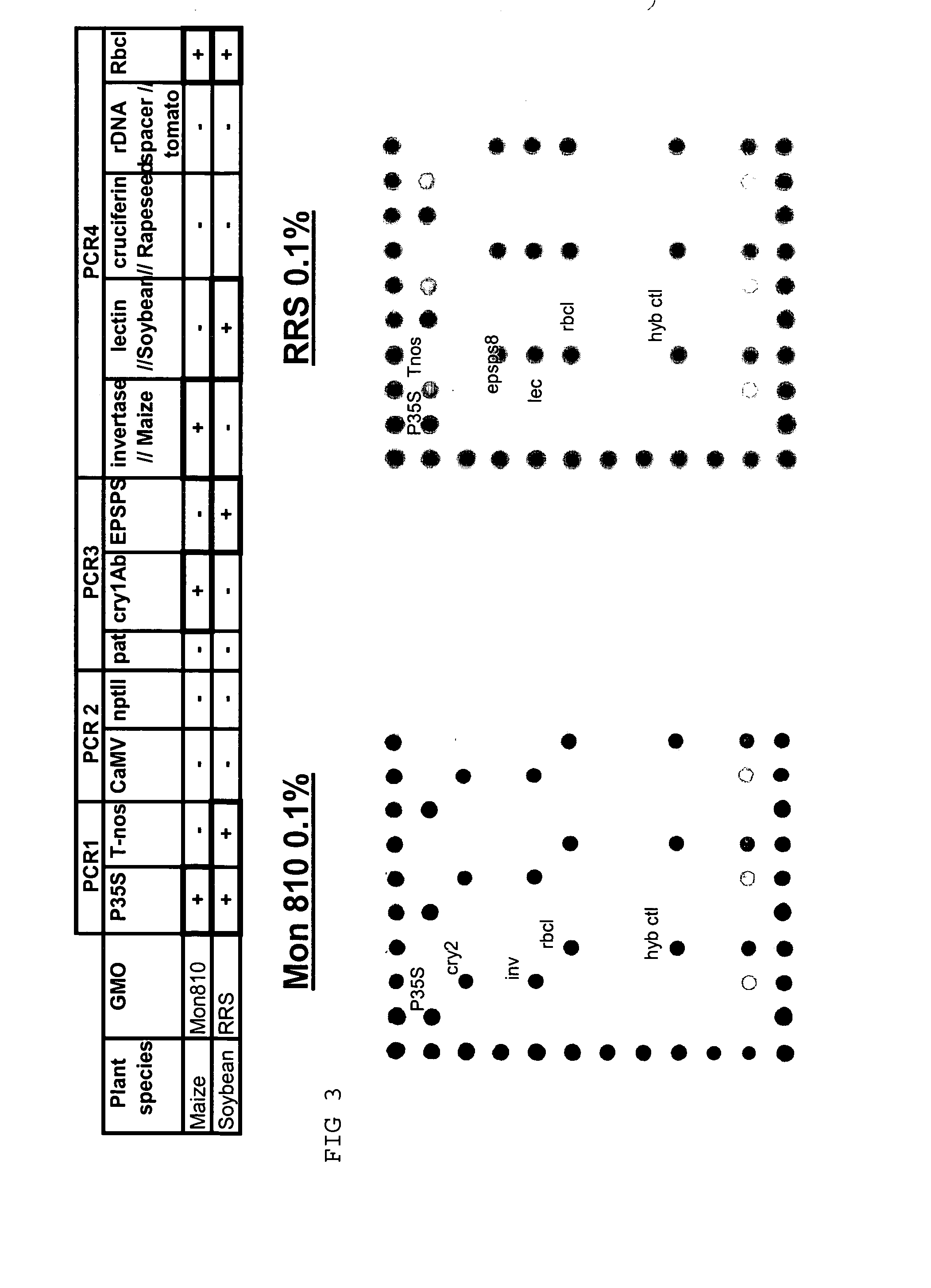Identification and/or quantification method of nucleotide sequence (s) elements specific of genetically modified plants on arrays
a nucleotide sequence and array technology, applied in the field of diagnosis, can solve the problems of lack of sensitivity of the method, inability to detect directly amplicons, and inability to achieve the identification of one or several organisms. the effect of simple identification
- Summary
- Abstract
- Description
- Claims
- Application Information
AI Technical Summary
Benefits of technology
Problems solved by technology
Method used
Image
Examples
example 2
Detection of GMOs Target Sequence(s) on Array
Analysis of Genetic Elements of GMOs
[0137] The experiment is performed as proposed in example 1. Three PCR for the amplification of the following elements are performed:
[0138] PCR1:
for Nos terminator:TTGAATCCTGTTGCCGGTCTT(SEQ ID NO: 1)andCGCTATATTTTGTTTTCTATCGCG;(SQ ID NO: 2)35S Promotor:CGTCTTCAAAGCAAGTGGATTG(SEQ ID NO: 3)andTCTTGCGAAGGATAGTGGGATT;(SEQ ID NO: 4)nptII:CTCGACGTTGTCACTGAAG(SEQ ID NO: 5)andGATGGATACTTTCTCGGCAG;(SEQ ID NO: 6)PCR control:CCACCTGCTGACCCCGTC(SEQ ID NO: 7)andGGGACCCTCGCCCAGAAAC;(SEQ ID NO: 8)
[0139] PCR2:
CaMV:GTTGTTCTATTAGTTGCTCTT(SEQ ID NO: 9)andATGGCTAATCTTAATCAGATCC;(SEQ ID NO: 10)Pnos-nptII:CCTCGGTATCCAATTAGAGTC(SEQ ID NO: 11)andTTGTCTGTTGTGCCCAGTCAT;(SEQ ID NO: 12)
[0140] PCR3:
Pat:GAGGCGCAAGGTTTTAAGTCT(SEQ ID NO: 13)andCATCATGCCATCCACCATGC;(SEQ ID NO: 14)Cry1Ab:CMCWCAGAACAACAAYGTGC(SEQ ID NO: 15)andGWGCWCKGATGATGCTCACG;(SEQ ID NO: 16)EPSPS:CAAGTCGMTYTCCMACCGG(SEQ ID NO: 17)andCCTTGCCCGTATTGATGACG(SEQ...
example 3
Detection of GMOs Target Sequence(s) on Array Including Specific Plant Identification
[0147] The detection of the GMO is performed with 3 PCR and capture probes as described in example 2. In the following example, a four PCR is added for the analysis of the plant species
[0148] PCR4:
Lectin (Soybean):CATTACCTATGATGCCTCCACC(SEQ ID NO: 42)andAAGCACGTCATGCGATTCC(SEQ ID NO: 43)Cruciferin (Rapeseed):AGAGACGAAGGAAGCGAAGG(SEQ ID NO: 44)andTGACCCATCTAATGCTGACG(SEQ ID NO: 45)Invertase (Maize):GCGCTCTGTACAAGCGTGC(SEQ ID NO: 46)andGCAAAGTGTTGTGCTTGGACC(SEQ ID NO: 47)rDNA (Tomato):GTTTCAAAAGTAACACGGCAA(SEQ ID NO: 48)andGGCTTGATAAATGAACTCAACT(SEQ ID NO: 49)Rbc1 (Plant universal):AGYCTTGATCGTTACAAAGG(SEQ ID NO: 50)andAGGTCTAADGGRTAAGCTAC;(SEQ ID NO: 51)the following specific sequence(s) arepresent on the capture probes:for the soybean lectin:CTGCCACGGGACTCGACATACCT(SEQ ID NO: 52)for the rapeseed cruciferin:TTCAGAGTGCTGATGTAACCGAGCT(SEQ ID NO: 53)for the maize invertase:TTAGACGGGAAAACGAGAGGAAGC(S...
PUM
| Property | Measurement | Unit |
|---|---|---|
| Length | aaaaa | aaaaa |
| Fraction | aaaaa | aaaaa |
| Electrical conductance | aaaaa | aaaaa |
Abstract
Description
Claims
Application Information
 Login to View More
Login to View More - R&D
- Intellectual Property
- Life Sciences
- Materials
- Tech Scout
- Unparalleled Data Quality
- Higher Quality Content
- 60% Fewer Hallucinations
Browse by: Latest US Patents, China's latest patents, Technical Efficacy Thesaurus, Application Domain, Technology Topic, Popular Technical Reports.
© 2025 PatSnap. All rights reserved.Legal|Privacy policy|Modern Slavery Act Transparency Statement|Sitemap|About US| Contact US: help@patsnap.com



